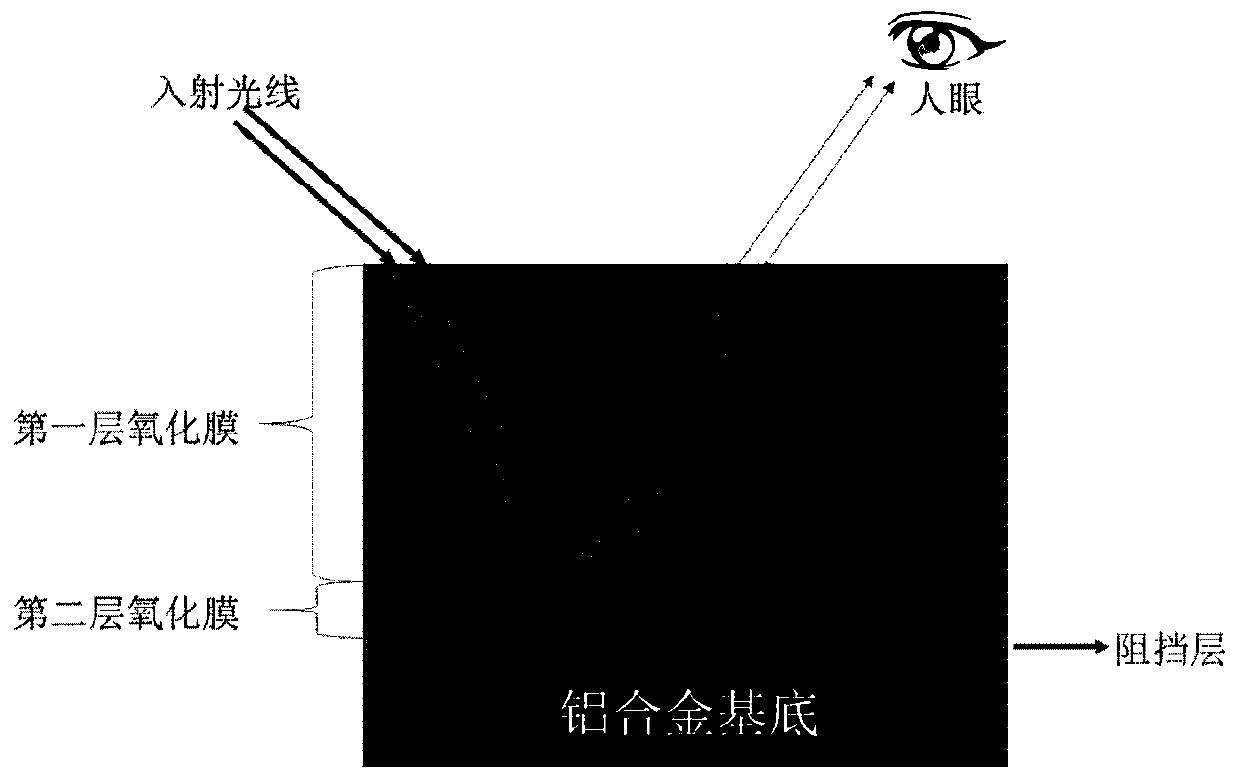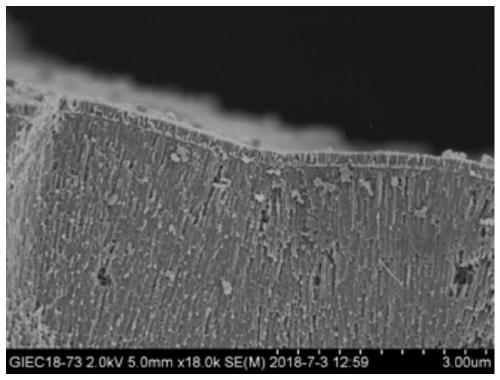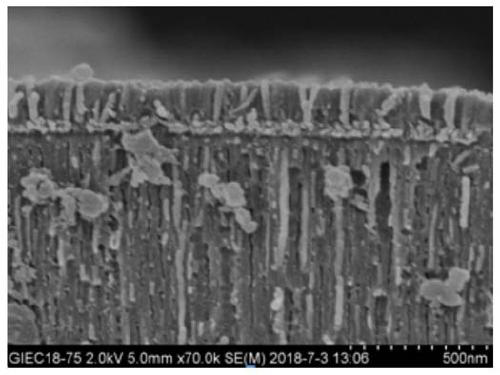Interference coloring method for aluminum alloy surface double-layer microstructure thin film
A technology of aluminum alloy surface, thin film interference, applied in the direction of surface reaction electrolytic coating, coating, electrolytic coating, etc., can solve the unstable color rendering of aluminum alloy, the color and weather resistance of aluminum alloy products cannot be balanced, and the coloring microscopic mechanism is unknown. and other problems, to achieve the effect of convenient industrial production, low output voltage accuracy requirements, and easy control
- Summary
- Abstract
- Description
- Claims
- Application Information
AI Technical Summary
Problems solved by technology
Method used
Image
Examples
Embodiment 1
[0043] 1) Put the aluminum alloy sample in 45g / L NaOH, 1g / L C 12 h 25 SO 4 Alkaline etching in a mixed solution of Na for 3 minutes. Rinse the sample after alkali etching with pure water and put it in 10% H 2 SO 4 , 4% HNO 3 Pickling in the mixed solution for 4 minutes, after treatment, ensure that the surface of the sample is smooth and clean, with the same surface state;
[0044] 2) Put the pretreated sample into 108g / L sulfuric acid solution for anodic oxidation, the oxidation temperature is 10°C, and the current density is 1.2A / dm 2 , and the cathode plate is made of high-purity graphite plate;
[0045] 3) After cleaning the oxidized aluminum alloy sample with pure water, put it into SnSO 4 and NiSO 4 Alternating current (AC) and direct current (DC) multiple superposition (AC-DC-AC-AC-DC-AC) electrodeposition is carried out in the deposition solution of the main salt, and the deposition temperature is 25°C.
[0046] Wherein, the composition of deposition liquid is: ...
Embodiment 2
[0064] 1) Put the aluminum alloy sample in 45g / L NaOH, 1g / L C 12 h 25 SO 4 Alkaline etching in a mixed solution of Na for 4 minutes. Rinse the sample after alkali etching with pure water and put it in 10% H 2 SO 4 , 4% HNO 3 Pickling in the mixed solution for 5 minutes, after treatment, ensure that the surface of the sample is smooth and clean, with the same surface state; 2) Put the pre-treated sample into 180g / L sulfuric acid solution for anodic oxidation, and the oxidation temperature is 25°C , the current density is 1.5A / dm 2 , and the cathode plate is made of high-purity graphite plate;
[0065] 3) After cleaning the oxidized aluminum alloy sample with pure water, put it into SnSO 4 and NiSO 4 Alternating current (AC) and direct current (DC) multiple superposition (AC-DC-AC-AC-DC-AC) electrodeposition is carried out in the deposition solution of the main salt, and the deposition temperature is 25°C.
[0066] Wherein, the composition of deposition liquid is:
[0...
Embodiment 3
[0084] 1) Put the aluminum alloy sample in 45g / L NaOH, 1g / LC at a temperature of 70°C 12 h 25 SO 4 Alkaline etching in a mixed solution of Na for 3 minutes. Rinse the sample after alkali etching with pure water and put it in 10% H 2 SO 4 , 4% HNO 3 Pickling in the mixed solution for 5 minutes, after treatment, ensure that the surface of the sample is smooth and clean, with the same surface state;
[0085] 2) Put the pretreated sample into 180g / L sulfuric acid solution for anodic oxidation, the oxidation temperature is 20°C, and the current density is 1.4A / dm 2 , and the cathode plate is made of high-purity graphite plate;
[0086] 3) After cleaning the oxidized aluminum alloy sample with pure water, put it into SnSO 4 and NiSO 4 Alternating current (AC) and direct current (DC) multiple superposition (AC-DC-AC-AC-DC-AC) electrodeposition is carried out in the deposition solution of the main salt, and the deposition temperature is 25°C.
[0087] Wherein, the composition...
PUM
 Login to View More
Login to View More Abstract
Description
Claims
Application Information
 Login to View More
Login to View More - R&D
- Intellectual Property
- Life Sciences
- Materials
- Tech Scout
- Unparalleled Data Quality
- Higher Quality Content
- 60% Fewer Hallucinations
Browse by: Latest US Patents, China's latest patents, Technical Efficacy Thesaurus, Application Domain, Technology Topic, Popular Technical Reports.
© 2025 PatSnap. All rights reserved.Legal|Privacy policy|Modern Slavery Act Transparency Statement|Sitemap|About US| Contact US: help@patsnap.com



